Lens Testing, Round 1
Part 7. Vignetting
In this test, we will look at the test images from all the lenses to compare evenness across the image wide open vs. stopped down. The differences will be apparent. Most lenses show a darkening of the corners at wide apertures, because the barrel of the lens cuts off some of the light reaching the film's corners. But some lenses are worse than others. Generally, stopping down is the solution to vignetting, because is hides the barrel behind the edge of a smaller aperture.
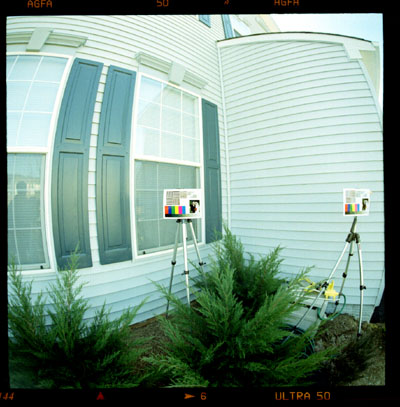
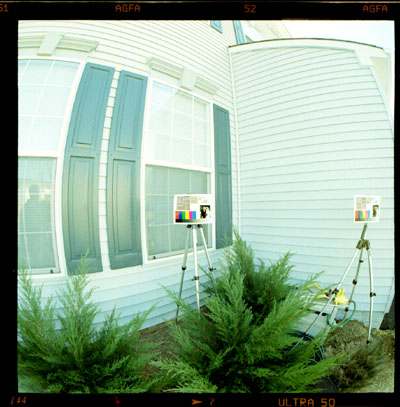
The 30mm shows significant vignetting--not surprising for this sort of lens. Stopping down solves the problem.

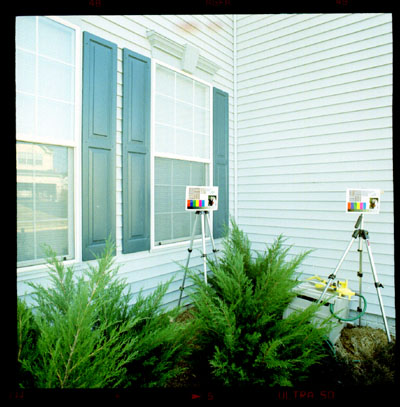
The 45mm Mir also vignettes a bit, and you can see the clear increase in depth of field for the stopped-down photo at right.
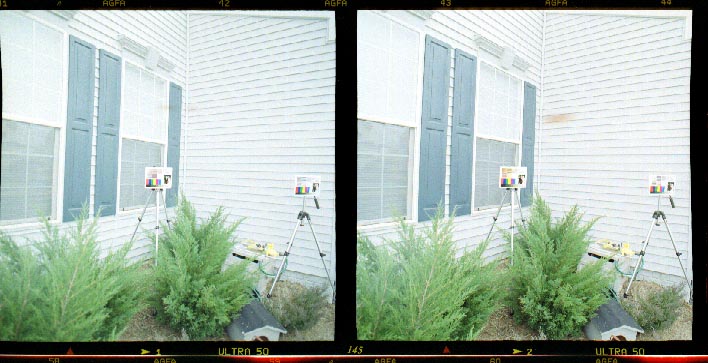
The 45mm Hartblei PCS lens performs similarly to the Mir when not shifted, but the contrast is better, though you can't see it in this image.
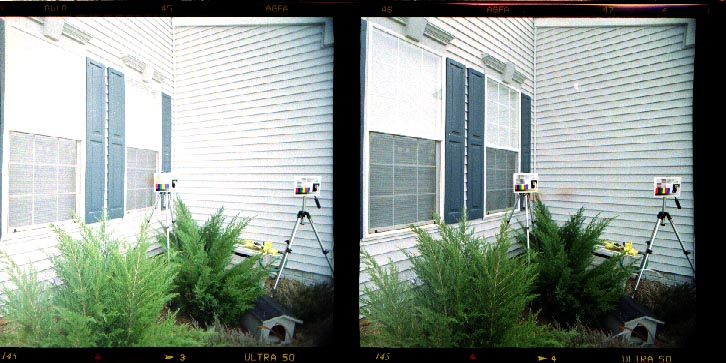
The Hartblei 45mm PCS lens shifted a full 12 mm. Markings on the shift control beyond 10mm are in red to warn of vignetting caused by limitations of coverage of this shifting lens. Sure enough, these images show significant vignetting, but nothing that can't be fixed with a little burning of the corners. The exposure difference was a blunder--they are both at the same shutter speed despite the 2-1/2 stops difference in aperture. Note that the upper right corner is visibly soft even in this low-resolution scan, but that stopped down it is much better.
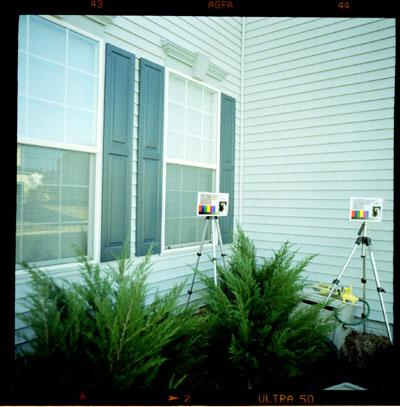
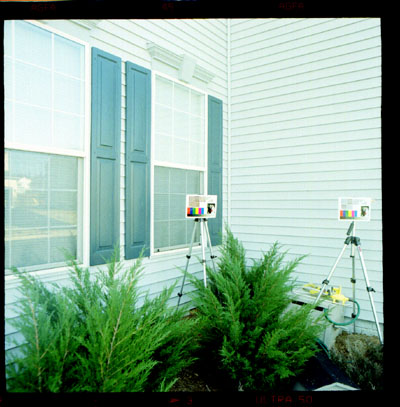
The Flektogon showed more vignetting wide open than the Mir.
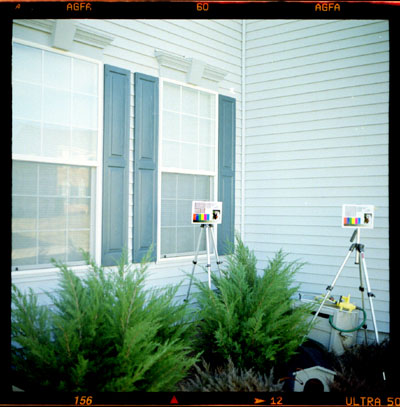
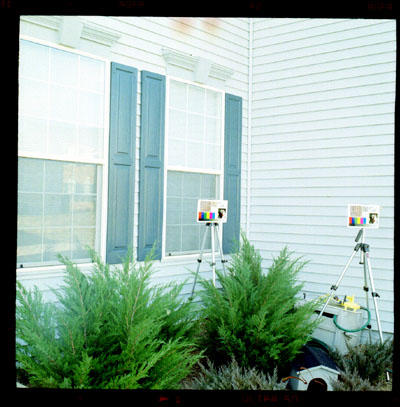
The 80mm normal lenses vignette a surprising amount.
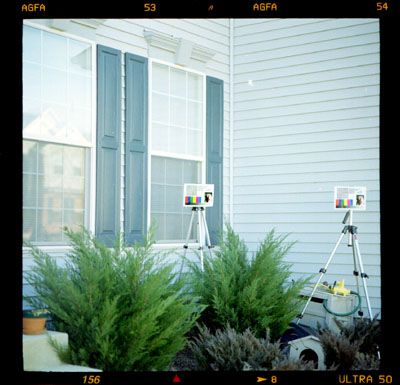
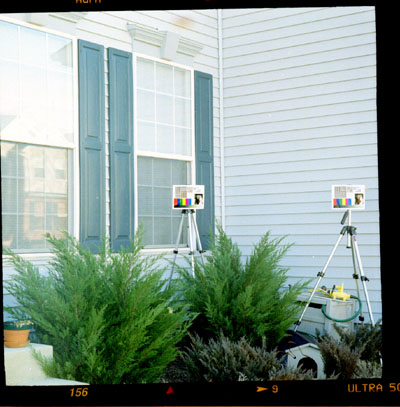
The 120mm Vega showed only slight darkening in the corners.
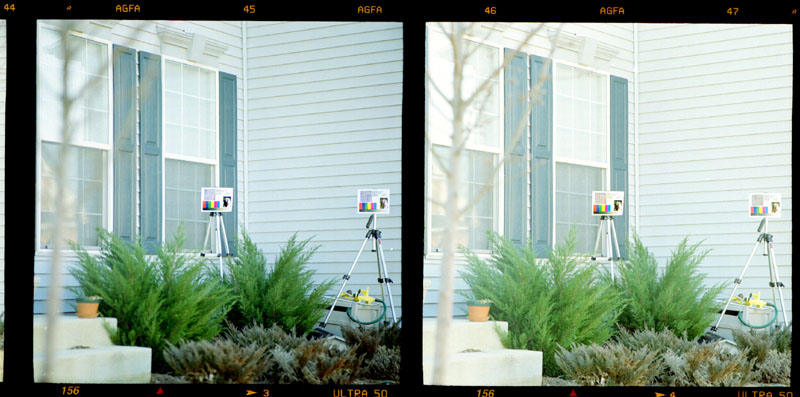
The Sonnar showed no vignetting. You can see that the stopped-down photo was given a bit more exposure than the wide-open shot.
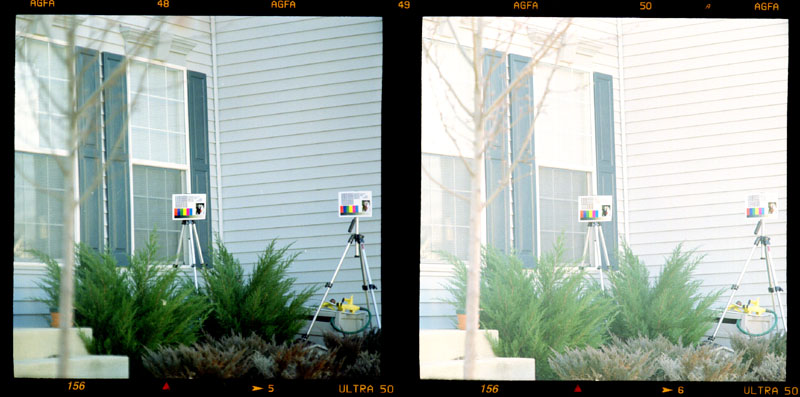
The difference in exposure was greater with the teleconverted Vega. Was this a blunder?
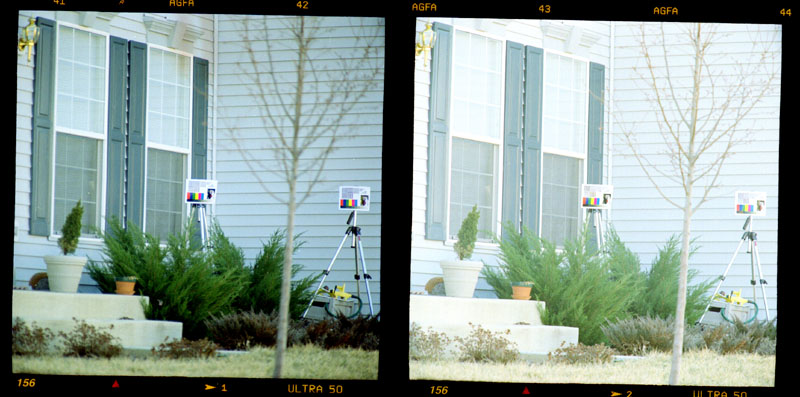
The teleconverted Sonnar showed the same difference in exposures, suggesting that it affects exposure in a non-linear manner. Hmmm--this requires more testing!
Conclusions
So, all in all, the star of the show was the Arsat fisheye. We've long known it was the best of the Arsenal litter, and this supports that expectation.
Generally, the old Sonnar and the Vega both performed really well, but something made the Sonnar perform worse stopped-down. That defies all optical logic, and the best guess at this point is that there is a specific and subtle flaw right in the center of one of the interior elements that is not apparent when wide open but becomes more apparent when stopped down. To say this is unusual would be understating the case. It's not a satisfying explanation on a number of fronts, but the other possibilities are refuted by the evidence.
The Vega is a wonderful lens--performing as well as the normal lenses.
The Flektogon was a disappointment. It was excellent in the center of the frame, but there was noticeable coma at the edges, causing the vertical bars to resolve far better than the horizontal bars. It was much better than the Mir in the center, but not as good at the edges.
My Mir is clearly a good one. Though it performed the worst of all the non-doubled lenses, it was better in many categories, and only slightly worse than the Flektogon. Wide angle lenses must be hard to build well! But this Mir is in the hunt with all these lenses, and clearly I can use it with confidence. The multicoated and tweaked version of this lens, made by Hartblei and mounted in a perspective-control shifting lens barrel, was better at the edges than the Mir, but not as good in the center.
The teleconverter did pretty well considering that I was comparing it against prime lenses. The question for a teleconverter is this: Does it perform better than another 2x enlargement of the negative? The answer is clearly yes, and therefore it remains in the camera bag. It adds chromatic aberration and reduces contrast, and it may affect exposure differently stopped down than wide open. If I needed lenses longer than the 180 for critical work, I'd look into a longer prime lens. (I don't.)
All the lenses demonstrated visible vignetting wide open, with the wide angles being worse than the telephotos. Nothing unexpected here.
Finally, some perspective. The worst lens resolved lines that would be 0.01" apart in an 11x14 print, which is a quarter-millimeter. From anything remotely near to proper viewing distance, that would be just fine. The worst performance when used optimally was twice that good. And the best performance was likely hidden by a host of other limitations, and the lens that performs well on the bench may well not get the opportunity in the real world if our technique isn't flawless.
One person wondered if we'd be better off with better lenses on 35mm cameras. Just the question suggests that too many conclusions might be drawn from this non-rigorous test. So...
...be careful not to draw too many conclusions.
For example, let's do that 35mm comparison.
The negative is twice as big in one dimension with medium format. That means that it contains nearly four times as much information. But would a lens with twice the resolving power as what I measured really give you as good an image? No, because it would still not contain as much information. The shadings and tonality would not be as good, even if the edges were as sharp.
But, even more importantly, the limitations of technique that brought the numbers down in my test would have been there as well for the 35mm system. Except that the 35mm camera is smaller, lighter, and less likely to be screwed down to a tripod (hint: this makes things worse). So, I'd probably be limited to about 44 lines/mm with a Summicron as I would on an Arsat, because that's the limitation of my technique. But 1/44 of a millimeter on 35mm film is a quarter-millimeter on an 11x14 print, whereas 1/44 of a mm on roll film is one-sixth of a mm on the 11x14-inch print. The lens is only at its best bolted down to a bench tester, and in my world the camera is resting on my hand or on a tripod that's swaying in the breeze.
The point in producing these tests is to realize something I've been saying all along: Sharpness is perceived, not measured. It stems from composition, subject matter, contrast, and, lastly, resolving power.
I'm much happier about my lenses now that I've tested them--I know what I can count on from each. If I want sharpness to the edges, the Flektogon may not be IT for me. The Hartblei will be better, and even the Mir. But if I'm taking a picture of something that needs sharpness in the middle plus the sweeping view of the wide angle lens, then the Flektogon is sharper in the middle than any of my other lenses when stopped down, save only the fisheye. And it's far better in the center than the Mir wide open. So, even though it was a disappointment in some ways, in other ways it excelled, even compared to the normal lenses.
In my final scoring, the wide angles (save the fisheye) were the worst performers OVERALL, except for the teleconverted lenses. But this is true always--rectilinear wide angles are difficult and always show the most compromise. But their images often appear sharper. Why? Because of the way they compress so much scenery detail into the frame. It tricks the viewer into an impression of sharpness.